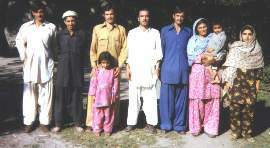
Damik is next to the larger village of Jinjoret and is directly across the Chitral River from Kalkatuk, which is the home of Prince Mohay-ud-Din, the Minister of State of Tourism and Development in the Government of Pakistan, who is also the District Council Chairman of Chitral.
Jinjoret and Damik are three miles across and down the river from Drosh. Drosh is 26 miles South of Chitral Proper ("Khas Chitral").
In the photo, at the center is Amin-ur-Rehman Chughtay, the cousin of my wife and also the Education Officer of Drosh. The name Chughtay comes from the fact that the Royal Family of Chitral (of which all in the photo are members) is descended from Chughtay (also spelled Jagatai, Chagatai and various other ways), the second son of Genghis Khan, who became the ruler of an area called Kashgaria, which included Kashgar and apparently bordered on Chitral. Chughtay had 13 children.
 |
Mitar Aman-ul-Mulk is said to have had 72 children, but only 25 were sons and only 16 of his sons were considered candidates to succeed him. One of the leading contenders was Prince Bahram-ul-Mulk. He and two of his brothers were invited to a meeting in Chitral Fort. Walking down a corridor while leaving that meeting, the three of them were jumped from above and ruthlessly murdered by agents of another brother named Afzal-ul-Mulk. This started an orgy of brothers killing each other to gain power. Finally, in 1895, a weak minded brother named Amir-ul-Mulk had yet another brother killed to gain power. He then invited the Nawab of Dir to come over and help. The Nawab came with his army, crossing a high mountain pass from Nuristan. The Nawab of Dir, with Amir-ul-Mulk now only a nominal ruler, surrounded the Chitral Fort, which included six British Army officers, who had just coincidentally arrived in the area. They had been invited by Mitar Aman-ul-Mulk before his death, because Aman-ul-Mulk wanted to join British India as protection from the Afghans down the river. It was Aman-ul-Mulk who had insisted that the Durand Line be drawn in such a way that Chitral was part of the British Empire and not part of Afghanistan, which it had traditionally been.
 History books report that Aman-ul-Mulk always had a falcon sitting on his arm. What is that sitting on his left shoulder? |
On the other hand, the children of Prince Bahram-ul-Mulk were left destitute after their father had been killed. Even most of their lands were taken away from them. Prince Bahram-ul-Mulk was the great-great-great grandfather of my wife, Honzagool.
In the photo, to the left of the boy named Bahram-ul-Mulk is, I believe, Nisar, the other identical twin brother of my wife.
To the right of Wazir is the mother of Honzagool holding the son of Aziz-ur-Rehman, who is the brother of Amin-ur-Rehman.
The last lady on the right I cannot tell you her name (although I know her very well) because her husband, who is crazy, says that he will kill any man who looks upon the face of his wife.
Mohammad Ismail Sloan
For more about Honzagool, see: Honzagool . For a photo of Honzagool being prepared for marriage to me, see: Marriage Preparations .
For another photo from Damik, see: The Family of Shamema in Pakistan .The language spoken by all of the people in this photograph is Khowar. For more information about Chitral and about Khowar, see: Khowar English Dictionary, More about Khowar, and Khowar, the Language of Chitral .
A photo of Aman-ul-Mulk, Ruler of Chitral and Ancestor of Shamema Honzagool, is published in The Gilgit Game.
"Article 3:
gThe British Government thus agrees to His Highness the Amir retaining Asmar and the valley above it,as far as Chanak.His Highness agrees on the other hand that he will at no time exercise interference in Swat,Bajaur or Chitral,including the Arnawai or Bashgal valley.The British Government also agrees to leave to His Highness the Birmal tract as shown in the detailed map already given to His Highness,who relinquishes his claim to the rest of the Waziri country and Dawar.His Highness also relinquishes his claim to Chageh.?E
Under this article the British Government agreed to Afghanistan retaining eAsmar and the valley above it as far as Chageh?EConversely ,Afghanistan withdrew its claim to Swat,Bajaur,Chitral and also to Arnawai or Bashgal valley.The British Government relinquished its claim to Birmal and Afghanistan relinquished its claim to the erest of Waziri country except Birmal and Dawar and also Chageh.
Asmar is where Berikot is located and is across the river from Arandu. Under this treaty, Nuristan which is directly north of Asmar belongs to Afghanistan whereas Chitral which is NorthEast of Asmar is part of India,.
When the British left India and Pakistan became independant, they were the successors in interest to the Durand Treaty. Nevertheless, Afghans often argue that the Durand line no longer applies and that all of Pakistan West of the Indus River belongs to Afghanistan. This claim has often been the cause of violence and bloodshed in the region.
Here are links: